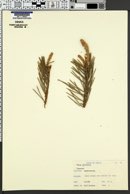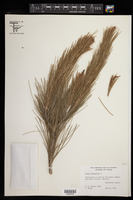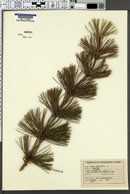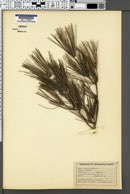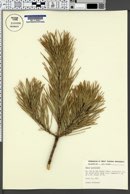

- Home
- Specimen Search
- Images
- Flora Projects
- Agency Floras
- Dynamic Floras
-
Additional Websites
- New Mexico Flores
- Plant Atlas Project of Arizona (PAPAZ)
- Southwest Colorado Wildflowers
- Vascular Plants of the Gila Wilderness
- Consortium of Midwest Herbaria
- Consortium of Southern Rocky Mountain Herbaria
- Intermountain Region Herbaria Network (IRHN)
- Mid-Atlantic Herbaria
- North American Network of Small Herbaria (NANSH)
- Northern Great Plains Herbaria
- Red de Herbarios del Noroeste de México (northern Mexico)
- SERNEC - Southeastern USA
- Texas Oklahoma Regional Consortium of Herbaria (TORCH)
- Resources
|
|
|
|
Family: Pinaceae
Scotch Pine
[Pinus mughus, morePinus sylvestris var. fastigiata] |
Varieties ca. 20 (1 introduced in the flora): North America, Eurasia. Tree 15 - 30 m tall, trunk diameter to 0.5 m Bark: pale gray and thin when young. Older bark is grayish brown, thick, fissured into scaly plates, peeling, and becoming distinctly orangish brown in the mid and upper trunk. Twigs: slender, reddish to orangish brown, becoming grayish brown and rough with age. Buds: reddish brown, about 6 mm long, cylindrical to egg-shaped, and pointed. Form: pyramidal to rounded and irregular. Pollen cones: yellow or pale pink, about 6 mm long, egg-shaped, and clustered at the base of new shoots. Needles: in clusters of two, waxy bluish green, 4 - 6 cm long, twisted, sharp-pointed, rigid, thick, and somewhat flattened. Young seed cones: purple, about 6 mm long, egg-shaped, at the tips of new shoots in the upper crown. Pollination between cones occurs mid to late May. Mature seed cones: woody, short-stalked, hanging downward, dull gray to yellowish brown, 3 - 8 cm long, and egg-shaped to somewhat spherical. Scales thin and flattened, thickening at the apex into a four-sided point, resembling a volcano. Seeds grayish to reddish brown, 3 - 6 mm long, with wings up to 15 mm long. Similar species: The similar Pinus banksiana differs by having yellowish green needles, curved, unarmed seed cones, and a scrubby overall appearance. Pinus pungens has slightly longer (5 - 10 cm) bluish green needles and heavy, egg-shaped seed cones bearing thick, prickled scales. Pinus virginiana has soft, flexible, dark green needles and reddish brown, egg-shaped seed cones which are armed with a prickle. Habitat and ecology: Introduced from Europe. Grows on just about any upland soil when planted, and flourishes on sandy loam soils. It has reproduced and naturalized well at Illinois Beach State Park south of Zion in Lake County, Illinois. Spontaneous plants also occur elsewhere in the Chicago Region, particularly near old plantings. Occurence in the Chicago region: non-native Notes: Pinus sylvestris is one of the most widely distributed pines in the world, with many races and varieties recognized. It is an attractive tree, often planted around buildings or homes, and is grown in plantations for Christmas trees. Some races of P. sylvestris are susceptible to the European pine shoot moth (Rhyacionia buolina), the pine wilt fungus, and Diplodia needle-cast disease, thereby rendering them undesirable in landscapes. The wood is used for general construction, pulp, posts, and boxes. Etymology: Pinus is the Latin word for pine. Strobus is the Latin word for pinecone. Author: The Morton Arboretum Tree to 30 m; bark of the larger branches and a segment of the main trunk conspicuously orange-brown and appearing blistered; lvs in 2's, bluish-green, usually twisted, 3-7 cm נca 1.5 mm; cones yellow-brown, soon reflexed, short-ovoid to oblong, often bent, 3-6 cm, the apophysis thickened, the umbo scarcely elevated, spineless. Native of Europe, occasionally escaped from cult. in our range. Gleason, Henry A. & Cronquist, Arthur J. 1991. Manual of vascular plants of northeastern United States and adjacent Canada. lxxv + 910 pp. ©The New York Botanical Garden. All rights reserved. Used by permission. |
|
|
|

Powered by Symbiota

































